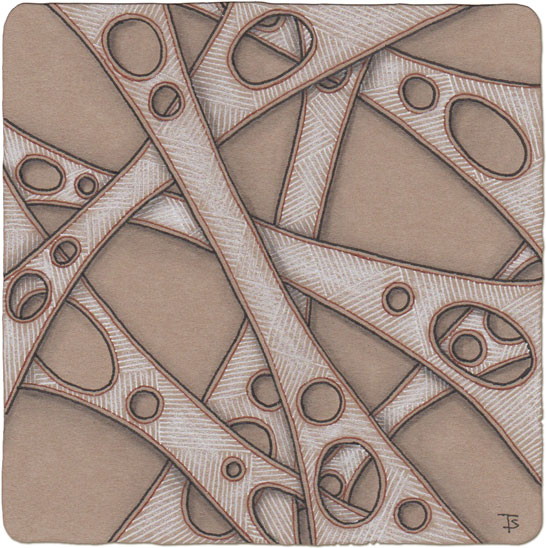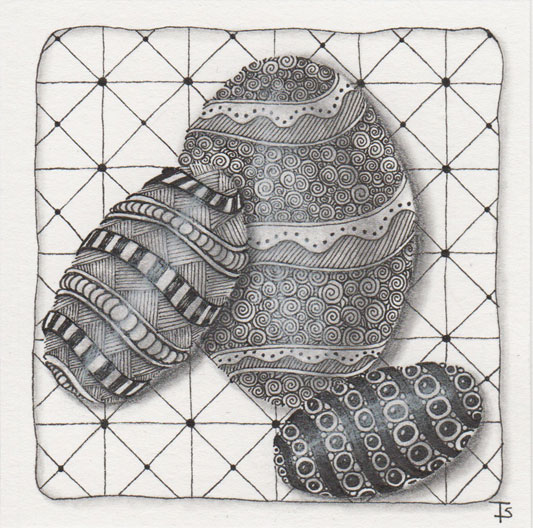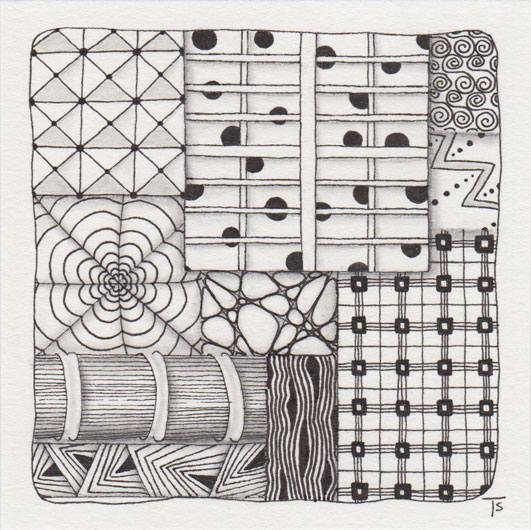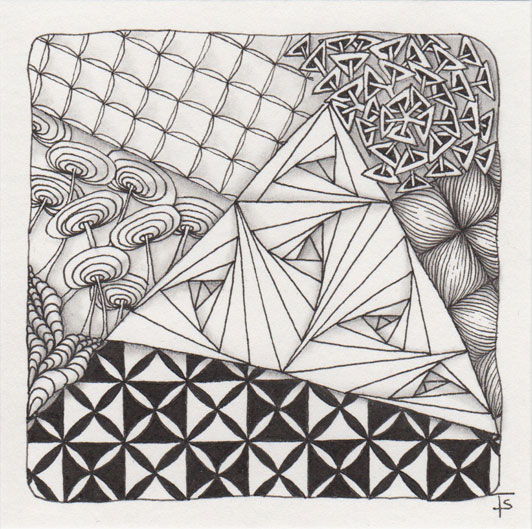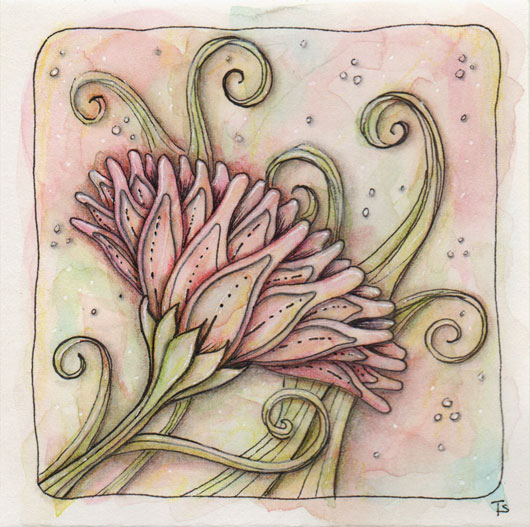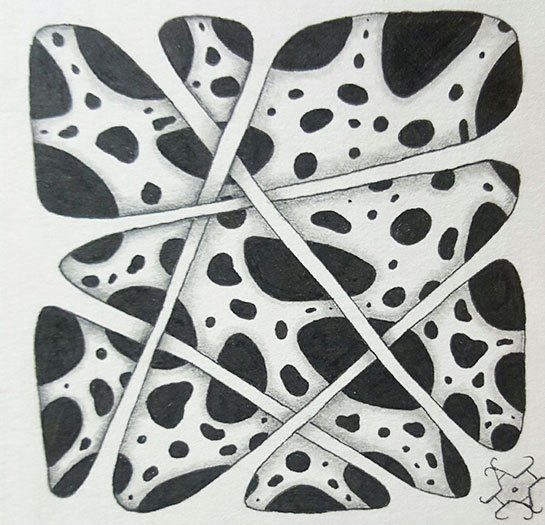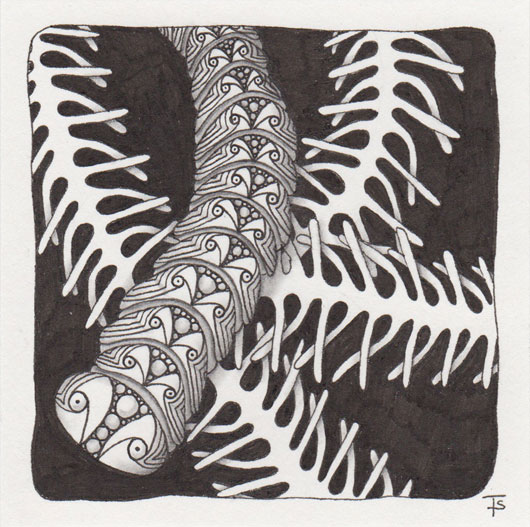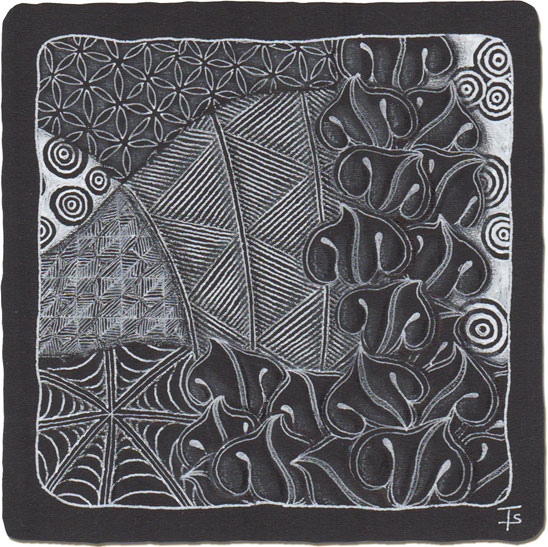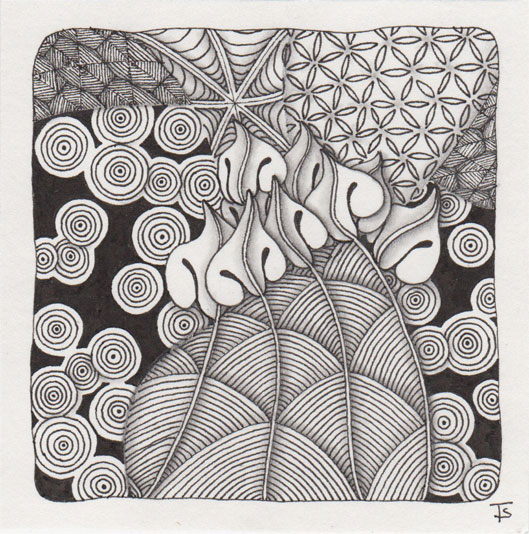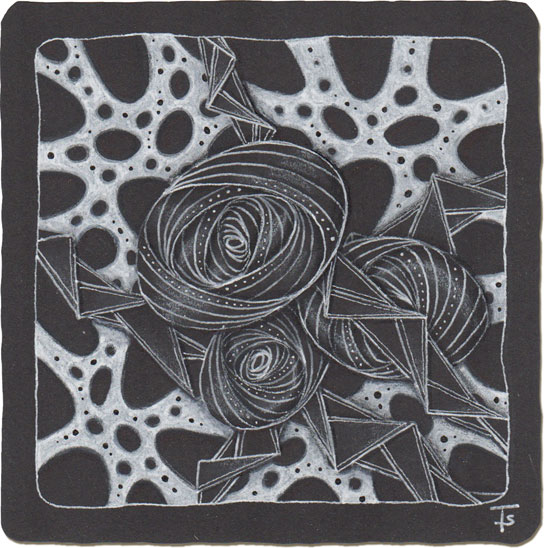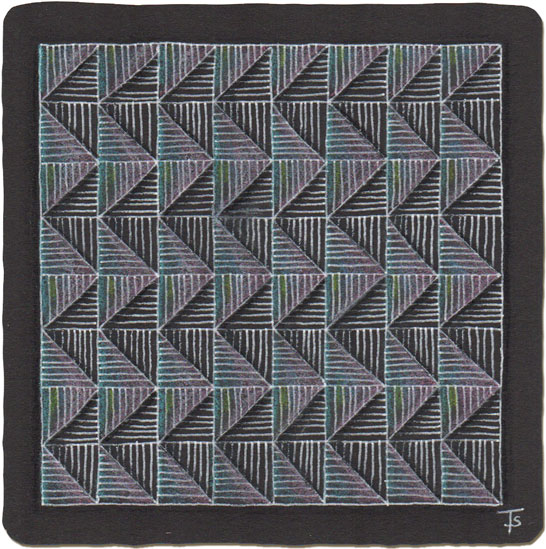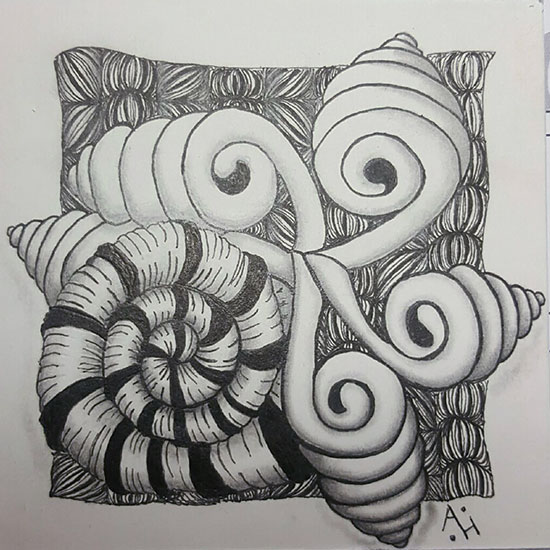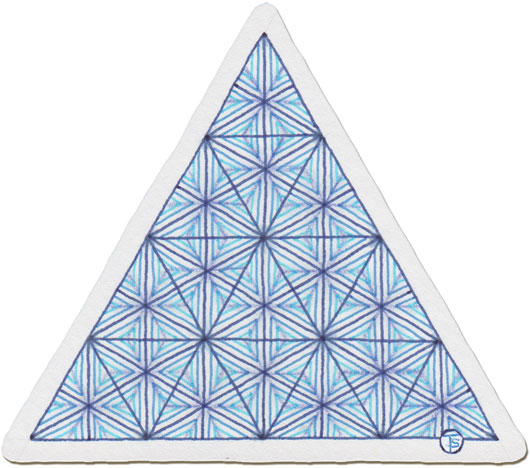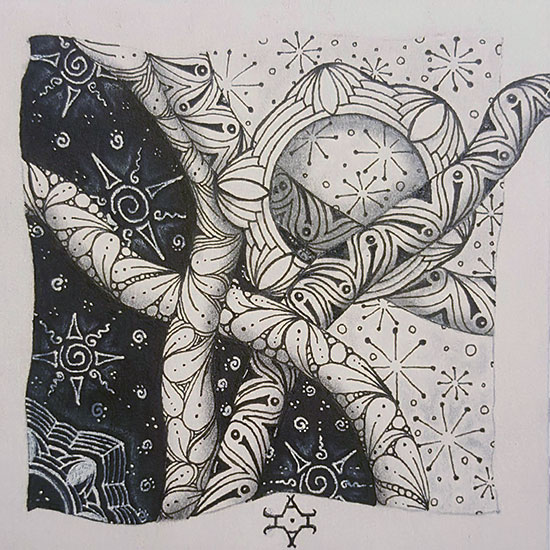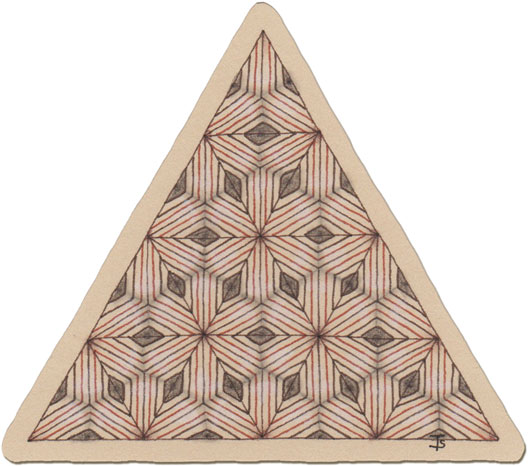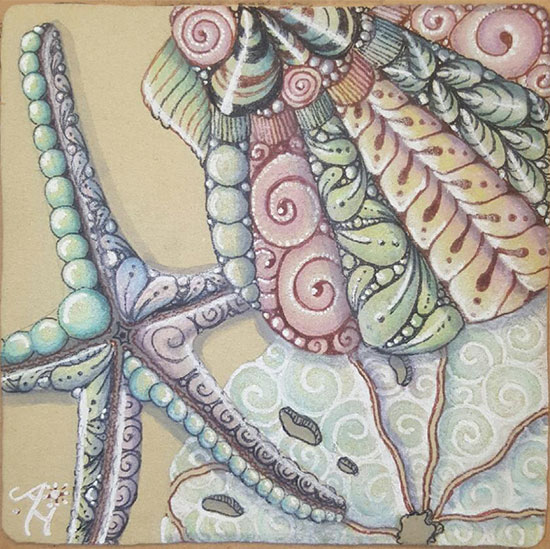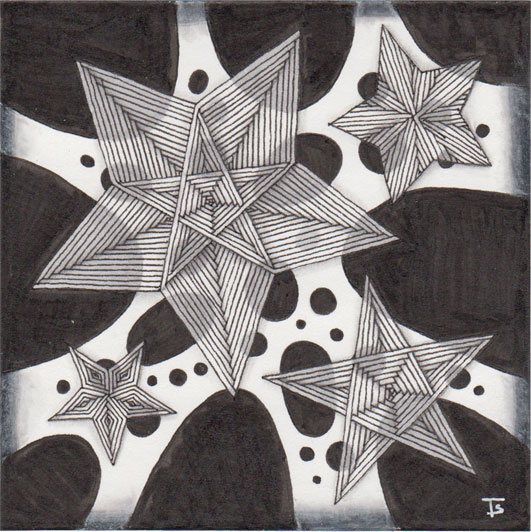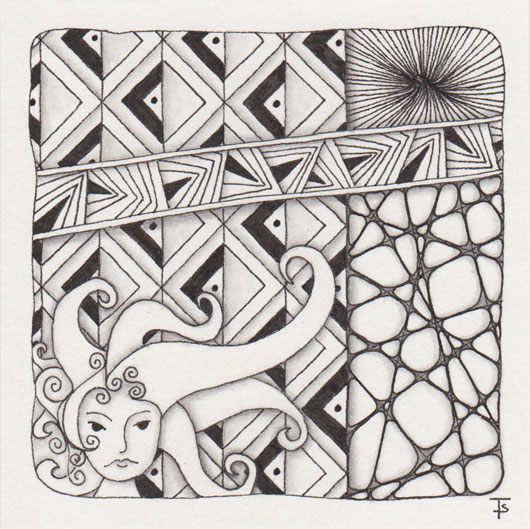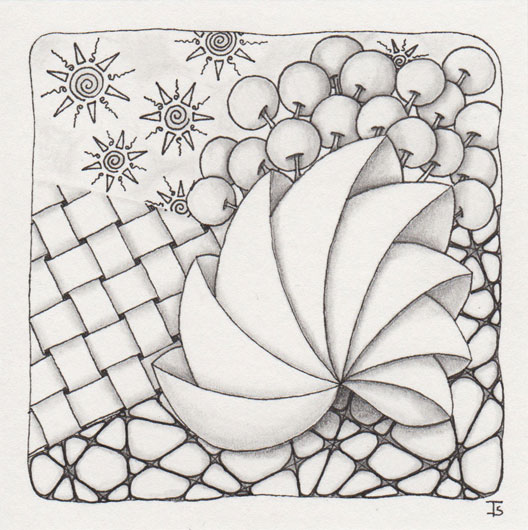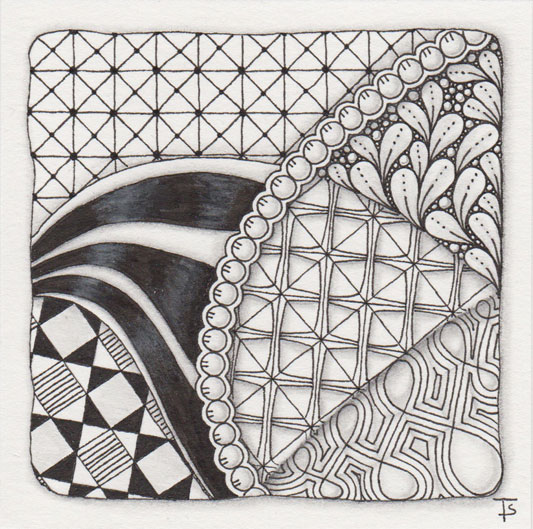WhollyHollibaugh.
Recently, Zentangle released a new video, #18, in the Kitchen Table series that illustrated the principle of seeing behind parts of a design through a window, or cutout in a tangle. Hollibaugh was used to illustrate this, so I decided to create this tile for my collection showing the concept. They call the tangle enhancement “Wholly Hollibaugh.”
Zentangle drawn on Stonehenge Kraft using black and brown Pigma Micron pens and Sakura white gel pen.
Incubation.
She found a group of eggs in various stages of growth in the Royal Nursery. She had no idea this was their method of reproduction until now. She wondered if each egg started with such elaborate patterns or if they were decorated after they were laid.
Zentangle drawn on Strathmore Vellum Bristol using a black, Micron pen. Shading done with graphite pencil.
Tangles: Caviar Meer Patena Printemps Purk Shattuck
Textiles.
She looked at varied shapes and textures hanging all around her in the stall. Of all the places on merchants row, this was the one that brought her the most inspiration. It was a never-ending kaleidoscope of color and patterns that constantly changed with the light.
Looking for new inspiration for strings for your tiles? Grab a magazine and open it to a random page. Look at the picture on it.
Crystalline.
The crystal structure at the center of the lab was stable, yet it would grow over time to take up more of the space. What would happen when it filled all of it? It was needed to keep the environment stable on the planet. Would the foliage survive? If the plants grew larger, could they control the crystals?
Zentangle drawn on Strathmore Vellum Bristol using a black, Micron pen.
Today’s tile is a doodle or a ZIA (Zentangle Inspired Art). I could have used tangles to decorate the flower petals, but I really liked the simplicity of just an aura and some dots.
If you would like to learn how to make decorative flowers, or have a better understanding of shading, or take your tangling to another level, I wholeheartedly recommend joining Eni Oken's Art Club . This tile is a result of following the instruction in her latest 3D Lotus Flower Video !
If you will recall, I was experimenting with using Membranart as a background behind other tangles, here . I made a fairly complex version of it to provide some tension with the foreground.
Amanda liked the idea of that, so she decided to experiment, also. She chose a simple tangle, Hollibaugh for the foreground so that she could concentrate on the Membranart itself. This was a new tangle for her to tackle, and I think she did a great job here!
Today’s focus came from a post in the Mosaic app by Maria Thomas. She illustrated a new way of drawing Molygon, which she referred to as articulated! I love this idea! It ends up looking a bit like a string of beads, or a caterpillar, depending on what you decide to draw inside of each segment.
I needed something to put behind it, and the very first tangle out of the jar was Locar!
Take two.
This Zentangle uses the same tangles that were used on Friday's tile . They are done, however, in a different string and on a black tile. I was curious to see how they would look.
I think Quandry looks good either way, and so does Shattuck. I definitly don’t like Toodles on the black tile. If I’m going to use it on black, I need to go about it a different way than I did here.
Decora.
The most interesting accessory in her small room in this section was the basket of Toodles. They grew everywhere on this station. The habitants used them for beauty, oxygen production, food, and their fibers produced by the fruits could be spun into textiles. At the end, the entire thing could be composted to start the cycle over again! She would collect some seeds from the biozone tomorrow. Perhaps they would be useful as she visited other habitats.
Inside.
She had passed through, to the other side of the barrier, beyond the stars. She could still see it in the distance. Now, she was confronted with the inner realms. She could see the stations, clustered together, ahead. Perhaps the structures connecting them also lead to others.
I decided to try my hand at creating a “regular” Zentangle, but using a black tile and white ink. This went through various stages of working and not working and then back to working again!
I chose a fairly simple tangle, Chard, for this tile so that I could do some experimentation. I’m at the point, working with black tiles, where I want to start adding a little bit of color. It’s kind of tricky because I want the color to show up, and not be muted. So for this tile, I’ve added a bit of white, first, and then put the color over it.
A really fun way to explore balance while maintaining interest is by using big, bold tangles! Here, Amanda has turned Springkle into a “blossom” or central motif by starting all the stems at the same point. The big, bold Marasu with the wonderfully irregular edges holds it’s own without being overwhelmed by the Springkle, however. What a wonderful balance vs tension between the two!
Zentangle drawn on Strathmore Vellum Bristol using a black, Micron pen.
This is another fragment experimentation. This time, I used Fragment A13 from the Zentangle Primer. This fragment is similar to the tangle Intersection by Suzanne McNeill. However, when you put them together, next to each other, they create an interesting, interlocking, triangular pattern. I chose to alter that with the shading by trisecting each one, creating a diamond pattern. Again, it’s amazing what optical illusions you can create with simple patterns and shading!
This tile was done by Amanda. I absolutely love it. She decided to experiment with having both a light and a dark background on the same tile, and I think it worked really well. I love the way it shows off the white “ribbons” of tangles on top of the dark areas. I am also super impressed by the intertwining of all the elements!
Zentangle drawn on Strathmore Vellum Bristol using a black, Micron pen and white, Sakura Gelly Roll pen.
Reticula.
I happen to love optical illusions. I think that’s one of the reasons that I love exploring Zentangle reticulum. By using some careful shading, this tile may look like a series of “Ys” or it may look like “blossoms”. Prior to shading, it looks a bit like the tangle Fassett! It’s a lot of fun to play with. The fragment used here is B13 from the Zentangle Primer.
This wonderful tile was created by my daughter. She is my student and protégé! She is such an amazing artist and she loves to be my class tester. It never ceases to amaze me what she will do and whether she will change something because she likes her way better. I’m so proud of her and so happy we will both become CZTs at the same seminar!
She saw my similar tile and asked me to teach her how to do it.
Beyond.
Now that she had decided, it was time to pilot beyond the local stars. She could see that something was there. Something mysterious. Something that was waiting to be explored.
This Zentangle started out as a challenge from another artist who said “You haven’t don’t very many tiles with Auraknot.” Then she challenged me to do one so she could see my variations and how I shaded them.
Revelation.
She stared up at the ceiling, trying to clear her mind. It was time to decide on a direction. Her ship was ready, but she was hesitating.
This is an interesting tile, from my perspective. Those of you who have been following my art for a while, know that sometimes I create random tiles and write a few lines of a story to go with them. They are always from the perspective of a female person, one that is travling around the universes in some kind of a ship, exploring various planets.
Beauty.
Even the smallest detail was graced with beauty. She was amazed at the lovely, ripe berries tucked, so carefully, within the perfect folds of the napkin at breakfast.
Zentangle drawn on Strathmore Vellum Bristol using a black, Micron pen. Shading done with graphite pencil.
Tangles: Bursti Crazy 'Nzeppel Phicops Poke-Root W-2
Choice.
She looked down at the floor and realized that there were so many choices, all woven together, that could make up the whole. While each one was different they were all part of the fabric of her life.
So far this year, I’ve done very few “regular” Zentangles. When I completed this one, and showed it to my daughter, she asked me, " Does it feel weird to do black and white now?
